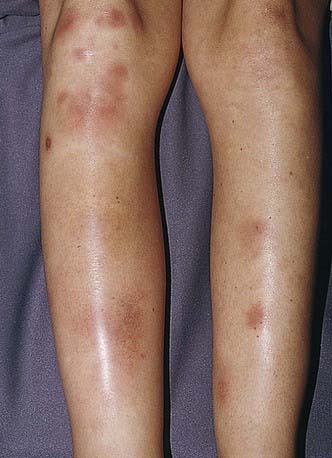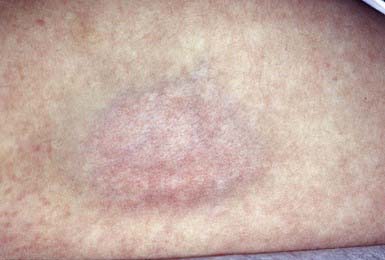Chapter 652 Diseases of Subcutaneous Tissue
Diseases involving the subcutis are usually characterized by necrosis and/or inflammation; they may occur either as a primary event or as a secondary response to various stimuli or disease processes. The principal diagnostic criteria relates to the appearance and distribution of the lesions, associated symptoms, results of laboratory studies, histopathology, and natural history and exogenous provocative factors of these conditions.
Corticosteroid-Induced Atrophy
Intradermal injection of a corticosteroid can produce deep atrophy accompanied by surface pigmentary changes and telangiectasia (Fig. 652-1). These changes occur approximately 2 wk after injection and may last for months.
652.1 Panniculitis and Erythema Nodosum
Inflammation of fibrofatty subcutaneous tissue may primarily involve the fat lobule or, alternatively, the fibrous septum that compartmentalizes the fatty lobules. Lobular panniculitis that spares the subcutaneous vasculature includes post-steroid panniculitis, lupus erythematosus profundus, pancreatic panniculitis, α1-antitrypsin deficiency, subcutaneous fat necrosis of the newborn, sclerema neonatorum, cold panniculitis, subcutaneous sarcoidosis, and factitial panniculitis. Lobar panniculitis with vasculitis occurs in erythema induratum and, occasionally, as a feature of Crohn disease (Chapter 328.2). Inflammation predominantly within the septum, sparing the vasculature, may be seen in erythema nodosum (Table 652-1 and Fig. 652-2), necrobiosis lipoidica, progressive systemic sclerosis (Chapter 154), and subcutaneous granuloma annulare (Chapter 649). Septal panniculitis that includes inflammation of the vessels is found primarily in leukocytoclastic vasculitis and polyarteritis nodosa (Chapter 161).
Table 652-1 ETIOLOGY OF ERYTHEMA NODOSUM
VIRUSES
Epstein-Barr, hepatitis B, mumps
FUNGI
Coccidioidomycosis, histoplasmosis, blastomycosis, sporotrichosis
BACTERIA AND OTHER INFECTIOUS AGENTS
Group A streptococcus,* tuberculosis,* Yersinia, cat-scratch disease, leprosy, leptospirosis, tularemia, mycoplasma, Whipple disease, lymphogranuloma venereum, psittacosis, brucellosis
OTHER
Sarcoidosis, inflammatory bowel disease,* estrogen-containing oral contraceptives,* systemic lupus erythematosus, Behçet syndrome, severe acne, Hodgkin disease, lymphoma, sulfonamides, bromides, Sweet syndrome, pregnancy, idiopathic*

Figure 652-2 Tender red nodules with indistinct borders in a teenage girl with erythema nodosum.
(From Weston AL, Lane AT, Morelli JG: Color textbook of pediatric dermatology, ed 3, St Louis, 2002, Mosby, p 212.)
Erythema Nodosum
Erythema nodosum is a nodular, erythematous hypersensitivity reaction that typically appears with multiple lesions on the exterior surfaces of the arms and legs in the pretibial area (more common) and less often in other cutaneous areas containing subcutaneous fat. The lesions vary in size from 1 to 6 cm, are symmetric, and are oval with the longer axis parallel to the extremity. They initially appear bright or dull red but progress to a brown or purple; they are tense and painful and usually do not ulcerate (see Fig. 652-2). Initial lesions may resolve in 1-2 wk, but new lesions may continue to appear for 2-6 wk. Repeat episodes may occur weeks to months later. Prior to or immediately at the onset of lesions, there may be systemic manifestations that include fever, malaise, arthralgias (50-90%) and rheumatoid factor negative arthritis.
The etiology is unknown in 30-50% of pediatric cases of erythema nodosum; other etiologies are noted in Table 652-1. Group A streptococcal infection and inflammatory disorders (inflammatory bowel disease) are common etiologies in children; sarcoidosis should be considered in young adults.
Post-Steroid Panniculitis
Etiology/Pathogenesis
The mechanism of the inflammatory reaction in the fat in post-steroid panniculitis is unknown.
Clinical Manifestations
Fewer than 20 cases of post-steroid panniculitis have been reported, with most of these being in children. The disorder occurs in children who have received high-dose corticosteroids. In 1-2 wk after discontinuation of the drug, multiple subcutaneous nodules usually appear on the cheeks, although other areas may be involved. Nodules range in size from 0.5 to 4 cm, are erythematous or skin colored, and may be pruritic.
Histology
A lobular panniculitis with a mixed infiltrate of lymphocytes, histiocytes, and neutrophils is seen. Scattered swollen adipocytes with eosinophilic, needle-shaped crystals are also seen. The epidermis, dermis, and fibrous septa of the fat are normal. Vasculitis is not seen.
Lupus Erythematosus Profundus (Lupus Erythematosus Panniculitis)
Etiology/Pathogenesis
It is unknown what separates those patients in whom lupus erythematosus profundus develops from other patients with systemic lupus erythematosus. This variant of lupus erythematosus is rare in childhood.
Clinical Manifestations
Lupus erythematosus profundus manifests as one to several firm, well-defined, purple plaques or nodules 1 to 3 cm in diameter, most commonly on the face, buttocks, or proximal extremities. This condition may occur in patients with systemic or discoid lupus erythematosus and may precede or follow the development of other cutaneous lesions. The overlying skin is usually normal but may be erythematous, atrophic, poikilodermatous, or hyperkeratotic (Fig. 652-3). Lesions may be painful and may ulcerate. On healing, a shallow depression generally remains or, rarely, soft pink areas of anetoderma result.
Histology
The histopathologic changes in lupus erythematosus profundus are distinctive and may allow the clinician to make the diagnosis in the absence of other cutaneous lesions of lupus erythematosus. The panniculitis is characterized by a mostly lobular dense infiltrate of lymphocytes and plasma cells. A dense perivascular and periappendigeal lymphocytic infiltrate is seen in the dermis. Lichenoid changes may be identified at the epidermal-dermal junction. Histopathologic differentiation from subcutaneous panniculitis–like T-cell lymphoma may be difficult. Results of lupus band and antinuclear antibody tests are usually positive.
Treatment
Nodules tend to be persistent. Hydroxychloroquine (2-5 mg/kg/day) is the treatment of choice for lupus erythematosus profundus. Intralesional corticosteroids may worsen the residual lipoatrophy. Immunosuppressive agents are indicated only for treatment of other severe manifestations of systemic lupus erythematosus. Avoidance of sun exposure and trauma is also important.
α1-Antitrypsin Deficiency
Etiology/Pathogenesis
Individuals with α1-antitrypsin deficiency have severe homozygous deficiency or, rarely, a partial deficiency of the protease inhibitor α1-antitrypsin, which inhibits trypsin activity and the activity of elastase, serine proteases, collagenase, factor VIII, and kallikrein (Chapter 385). Panniculitis occurs with the Z subtype.

Full access? Get Clinical Tree




